AMD Threadripper Pro Review: An Upgrade Over Regular Threadripper?
by Dr. Ian Cutress on July 14, 2021 9:00 AM EST- Posted in
- CPUs
- AMD
- ThreadRipper
- Threadripper Pro
- 3995WX
CPU Tests: Legacy and Web
In order to gather data to compare with older benchmarks, we are still keeping a number of tests under our ‘legacy’ section. This includes all the former major versions of CineBench (R15, R11.5, R10) as well as x264 HD 3.0 and the first very naïve version of 3DPM v2.1. We won’t be transferring the data over from the old testing into Bench, otherwise it would be populated with 200 CPUs with only one data point, so it will fill up as we test more CPUs like the others.
The other section here is our web tests.
Web Tests: Kraken, Octane, and Speedometer
Benchmarking using web tools is always a bit difficult. Browsers change almost daily, and the way the web is used changes even quicker. While there is some scope for advanced computational based benchmarks, most users care about responsiveness, which requires a strong back-end to work quickly to provide on the front-end. The benchmarks we chose for our web tests are essentially industry standards – at least once upon a time.
It should be noted that for each test, the browser is closed and re-opened a new with a fresh cache. We use a fixed Chromium version for our tests with the update capabilities removed to ensure consistency.
Mozilla Kraken 1.1
Kraken is a 2010 benchmark from Mozilla and does a series of JavaScript tests. These tests are a little more involved than previous tests, looking at artificial intelligence, audio manipulation, image manipulation, json parsing, and cryptographic functions. The benchmark starts with an initial download of data for the audio and imaging, and then runs through 10 times giving a timed result.
We loop through the 10-run test four times (so that’s a total of 40 runs), and average the four end-results. The result is given as time to complete the test, and we’re reaching a slow asymptotic limit with regards the highest IPC processors.
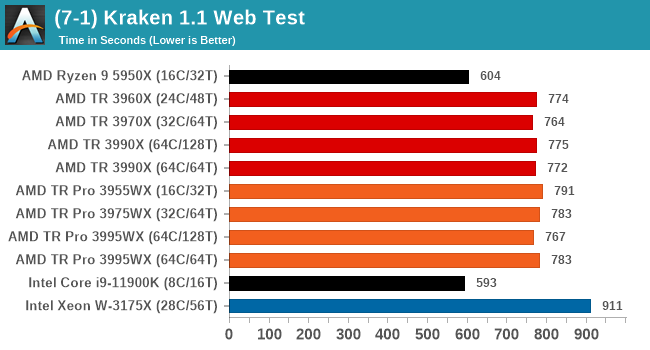
Google Octane 2.0
Our second test is also JavaScript based, but uses a lot more variation of newer JS techniques, such as object-oriented programming, kernel simulation, object creation/destruction, garbage collection, array manipulations, compiler latency and code execution.
Octane was developed after the discontinuation of other tests, with the goal of being more web-like than previous tests. It has been a popular benchmark, making it an obvious target for optimizations in the JavaScript engines. Ultimately it was retired in early 2017 due to this, although it is still widely used as a tool to determine general CPU performance in a number of web tasks.
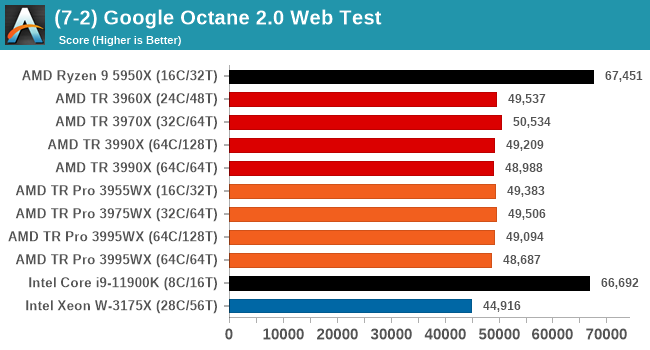
Speedometer 2: JavaScript Frameworks
Our newest web test is Speedometer 2, which is a test over a series of JavaScript frameworks to do three simple things: built a list, enable each item in the list, and remove the list. All the frameworks implement the same visual cues, but obviously apply them from different coding angles.
Our test goes through the list of frameworks, and produces a final score indicative of ‘rpm’, one of the benchmarks internal metrics.
We repeat over the benchmark for a dozen loops, taking the average of the last five.
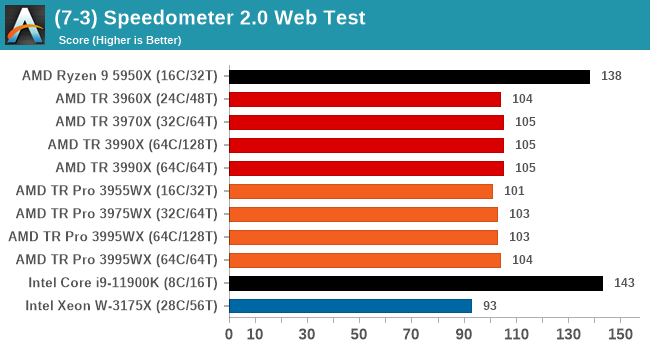
Legacy Tests
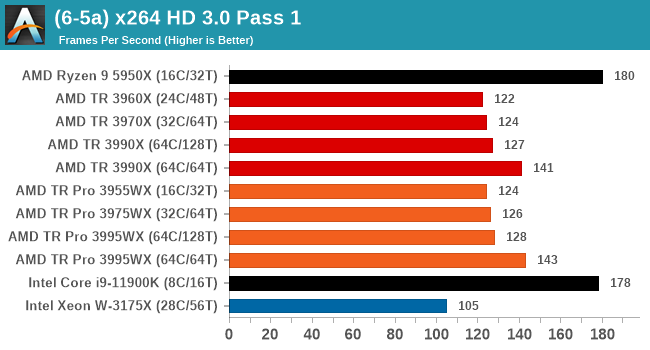
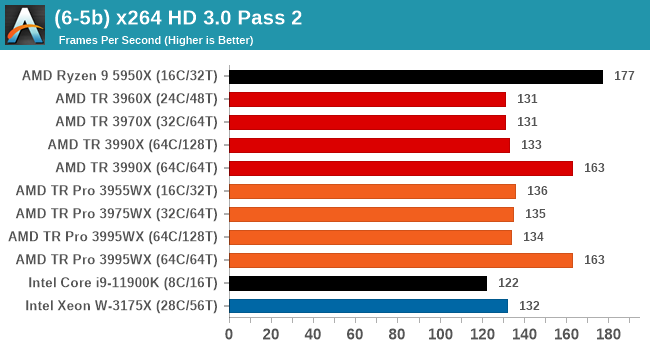
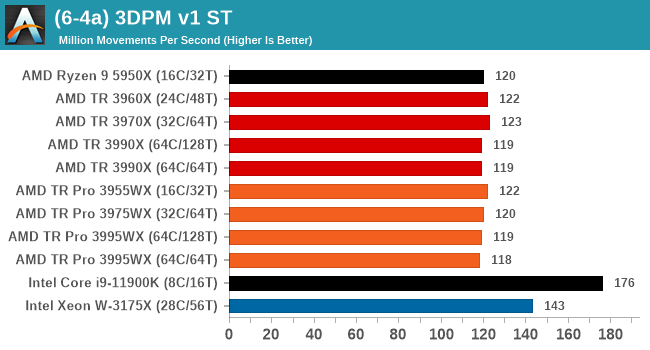
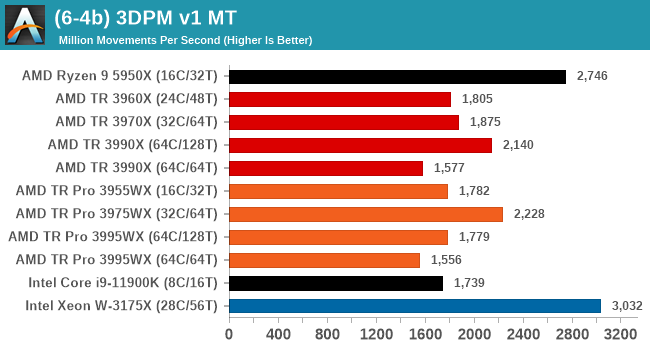

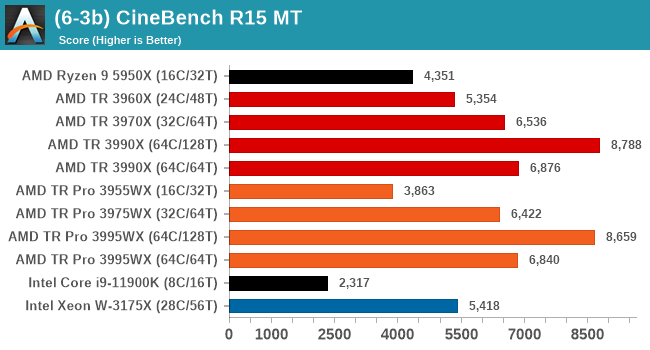


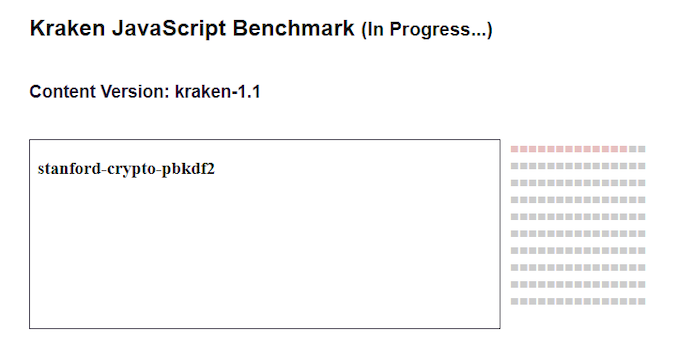

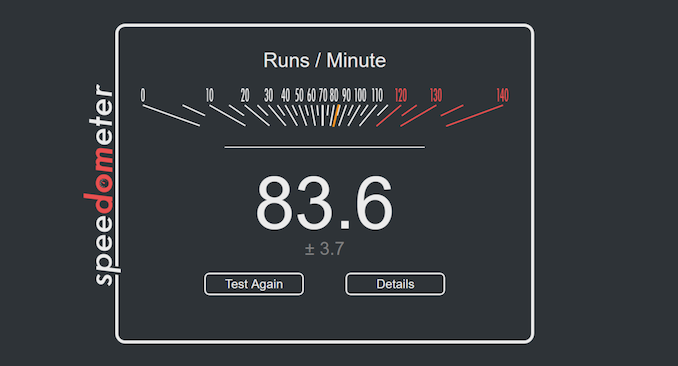








98 Comments
View All Comments
Threska - Tuesday, July 20, 2021 - link
VFIO would be more popular if video card makers weren't tight with GPU-pasthrough.https://forum.level1techs.com/t/the-vfio-and-gpu-p...
CPUs like Threadripper would be a great fit.
FLORIDAMAN85 - Wednesday, July 21, 2021 - link
Alt title: AMD, faster than Intel in Crysis, again.quadibloc - Thursday, July 22, 2021 - link
It's too bad it took so long for this chip to become generally available. I hope this won't be repeated in the next generation of Threadrippers - and they should have become available sooner. Like within a month of Ryzen, so that people could buy them before they're already obsolete.mode_13h - Thursday, July 22, 2021 - link
> Like within a month of Ryzen, so that people could buy them before they're already obsolete.First, how is it obsolete? TR 3000 and TR 3000 Pro are still peerless, in many ways.
Second, Intel has traditionally had like 6 months or a year of lag between their mainstream and HEDT. I know you didn't say anything about Intel, but I'm pointing this out because it establishes a precedent for what AMD is doing (not that I think AMD is worried about precedents).
alpha754293 - Thursday, July 29, 2021 - link
"file:///J:/Shared%20drives/AnandTech/Articles/20210706%20TR%20Pro/AMD%20Opens%20Up%20Threadripper%20Pro:%20Three%20New%20WRX80%20Motherboards"You might want to fix this link in your review.
Ryan Smith - Monday, August 2, 2021 - link
Thanks!0ldman79 - Thursday, July 29, 2021 - link
I can understand Lenovo locking their OEM CPUs to their motherboards as a packaged deal.If I read this correctly, ALL Threadripper Pro CPUs will be locked to Lenovo boards forever if they're ever installed in a Lenovo P620 motherboard.
That's a huge load of crap. No one is going to know this except for Anandtech readers and whatever poor schmuck that gets screwed a few years down the road.
Hopefully someone will figure out how to defeat that OEM lock. That is just poor judgment on AMD's part.
To clarify, I have zero problem with the CPU being locked to the Lenovo system *as it is sold*, but it is 100% unacceptable to lock a LATER installed CPU to the motherboard as well.
GregoriaEgan - Sunday, December 12, 2021 - link
So I was thinking about getting the low end 3955WX Threadripper Pro, but as I understand it the 24 Core "old" Threadripper are better because of more chiplets (and cores). I just saw a mentioning of TH "Pro" functions, I'm unsure, are there more functions of the Pro-line, like remote administration or the like?I doubt that I would ever get more than 256 GB RAM and I'm not sure that I need the extra PCI-e lanes, but are there any other more features that just don't exist in the non-pro TH, that you only get with the Pro-line?